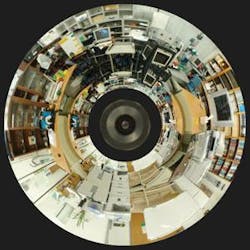Important to applications in robotics, virtual reality, and surveillance, panoramic stereo images are usually captured with two cameras and a catadioptric imaging system—one that uses lenses and mirrors to achieve a wide 3-D field of view. However, stereo images acquired by multiple cameras suffer for several reasons: the focal lengths of the cameras are not identical, the alignment of the imaging sensors is not accurate, and there are intensity differences between the two imaging sensors. These geometric and chromatic differences ultimately result in false matching for corresponding points in the stereo image.
While single-camera systems using a double-lobed mirror (a combined coaxial mirror pair) have been used to obtain stereo images, a critical deficiency of this technique is the short baseline, or small disparity between the two imaging points, making 3-D reconstruction almost impossible.
In a modified single-camera setup that uses two hyperboloidal mirrors and one planar mirror, however, scientists at the Korea Advanced Institute of Science and Technology (Daejeon, Korea) have developed a compact panoramic stereo imager that has a wide baseline to produce accurate 3-D images.1
The system setup consists of a 1/1.8-in.-image-size CCD camera with 1200 horizontal scan lines and a 12-mm-focal-length lens that captures the images obtained by the two 80-mm-diameter hyperboloidal mirrors, separated by the baseline distance of 120 mm. The CCD captures an upper radial view reflected from the upper hyperboloidal mirror to form the outer rim of the imaging circle. The lower hyperboloidal mirror reflects the lower radial view that is projected onto the central region of the imaging circle. The two images are combined to produce a radial image (see Fig. 1).
Panoramic stereo
To produce a panoramic stereo image from the upper and lower views of the scene, the relationship between a single imaged point in the scene and its projection onto the image plane is established by geometrical equations that incorporate physical parameters of the hyperboloidal and plane mirrors and the focal length of the camera. The catadioptric stereo system is designed to permit easy conversion from the catadioptric omnidirectional image to the panoramic image seen from a single effective viewpoint. By assuming that a virtual cylindrical plane is located at each virtual viewpoint and aligned to the axis of the system, the equations can be used to find correspondence between a point on the virtual cylindrical image plane and its projection onto the planar image plane. Rectified panoramic stereo images can then be reprojected from the radial catadioptric images by sampling the intensity for all the pixels on the virtual cylindrical image, enabling a 3-D estimation of any imaging point by simple triangulation (see Fig. 2).Despite observed problems such as radial defocusing (caused by the different focal lengths of the two hyperboloidal mirrors), and differences in image resolution between generated panoramic stereo images (caused by reduced stereo matching accuracy if the input image resolution is poor), researcher Gijeong Jang notes that the proposed system provides sufficient accuracy for various machine-vision applications in which panoramic range measurements are important.
REFERENCE
1. G. Jang et al., Optics Lett. 31 (1) 41 (Jan. 1, 2006).
About the Author

Gail Overton
Senior Editor (2004-2020)
Gail has more than 30 years of engineering, marketing, product management, and editorial experience in the photonics and optical communications industry. Before joining the staff at Laser Focus World in 2004, she held many product management and product marketing roles in the fiber-optics industry, most notably at Hughes (El Segundo, CA), GTE Labs (Waltham, MA), Corning (Corning, NY), Photon Kinetics (Beaverton, OR), and Newport Corporation (Irvine, CA). During her marketing career, Gail published articles in WDM Solutions and Sensors magazine and traveled internationally to conduct product and sales training. Gail received her BS degree in physics, with an emphasis in optics, from San Diego State University in San Diego, CA in May 1986.

